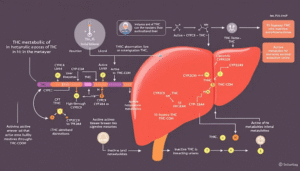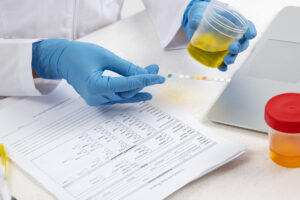Wondering how long does Suboxone stay in your system? Typically, it can be detected for about 7-10 days, depending on various factors like age, weight, and metabolism. This article will detail detection windows for urine, blood, saliva, and hair tests and discuss the factors influencing these times.
Key Takeaways
- Suboxone, a combination of buprenorphine and naloxone, is utilized to treat opioid addiction by reducing cravings and blocking opioid effects.
- Suboxone can be detected in the system for 7-10 days, with specific testing methods such as urine, blood, saliva, and hair tests providing varying detection windows.
- Factors influencing Suboxone detection times include dosage, frequency of use, metabolism rate, and liver function, with medical supervision recommended for managing withdrawal symptoms.
What is Suboxone?
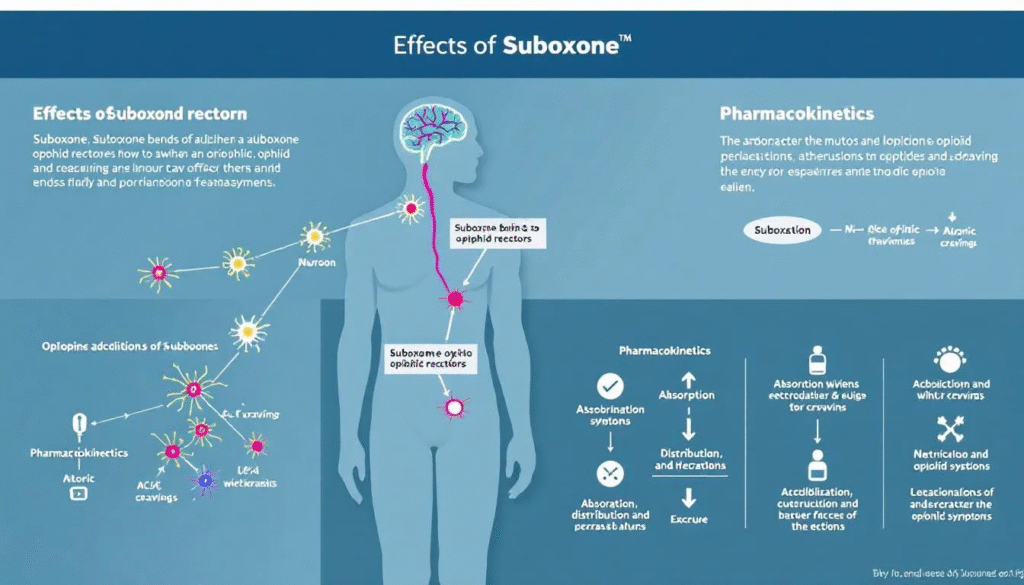
Suboxone is a powerful prescription medication. It is designed specifically to treat opioid addiction. Comprising buprenorphine and naloxone, it offers a lifeline to those grappling with substance use disorders. Approved for opioid addiction treatment in 2002, Suboxone has since become a cornerstone in the fight against opioid dependency. Typically administered as a dissolvable film or tablet, it provides an accessible and effective route to recovery.
Buprenorphine, one of Suboxone’s active ingredients, plays a crucial role in reducing cravings and preventing withdrawal symptoms, making it easier for individuals to manage opioid addiction. Naloxone, the other component, is included to block the effects of other opioids, thereby reducing the potential for abuse. This dual-action approach makes Suboxone a unique and effective tool in opioid addiction treatment.
How Does Suboxone Work?
The magic of Suboxone lies in its components. Buprenorphine, a partial agonist, binds to opioid receptors in the brain, producing mild effects compared to full opioids but enough to stave off withdrawal symptoms and cravings. This helps individuals maintain a more stable state, avoiding the drastic highs and lows associated with opioid use.
Naloxone, on the other hand, is an opioid antagonist. It works by blocking the effects of opioids, making it less likely that individuals will misuse suboxone. The opioid-blocking effects of naloxone typically last between 1 to 3 hours after ingestion, and suboxone block opioids.
Together, these components create a balanced approach to treating opioid addiction, making suboxone effective and reliable option for many.
How Long Does Suboxone Stay in Your System?
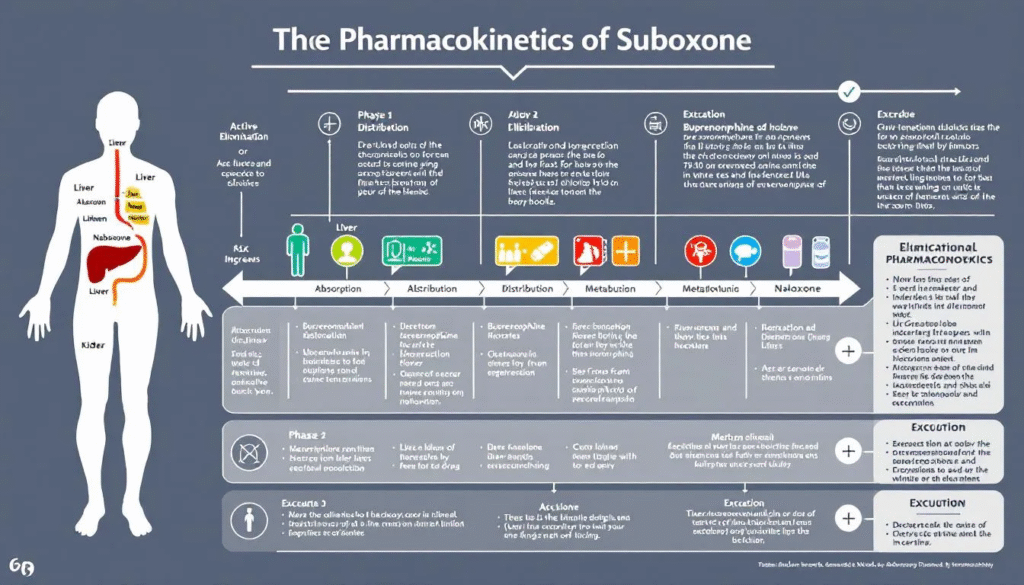
One of the most pressing concerns for those taking Suboxone is understanding how long it stays in the system. Typically, Suboxone remains detectable for about 7-10 days. However, this can vary based on several factors such as age, weight, history of drug abuse, and metabolism. This knowledge is crucial, especially if you’re preparing for a drug test or managing your medication regimen.
Suboxone can be detected through various testing methods, each with its own detection window. Understanding these methods and their specific detection times can help in planning and managing drug tests effectively. Let’s delve into the specifics of each testing method to get a clearer picture.
Urine Tests
Urine tests are one of the most common methods used to detect Suboxone. Typically, Suboxone can stay detectable in urine for about 5 to 8 days, with some tests extending up to 7 days. This method is widely used due to its simplicity and reliability, making it a go-to option for many drug tests.
However, factors like liver function can significantly influence the detection time. Individuals with normal liver function may clear Suboxone more quickly, while those with impaired liver function may retain the drug for longer periods. Understanding these nuances can help in interpreting urine test results more accurately.
Blood Tests
Blood tests offer another reliable method for detecting Suboxone. Buprenorphine, a key component, can be detected in blood tests for approximately 26 to 42 hours, while naloxone is detectable for a few hours to 1-2 days. The overall detection period for Suboxone in blood tests can extend up to 8 days.
Additionally, the metabolite norbuprenorphine may be detected in blood tests for 15-150 hours, depending on various factors. The peak blood concentration for Suboxone tablets is reached within 1 to 4 hours, whereas buccal films take about 3 to 4 hours.
Blood tests provide a precise snapshot of recent Suboxone use, making them a valuable tool in specific scenarios.
Saliva Tests
Saliva tests are a less common but non-invasive method to detect Suboxone. Key points about saliva testing for Suboxone include:
- Suboxone is typically detectable in saliva for up to 5 days.
- A small sample is collected from inside the mouth using a swab.
- The collected sample is then analyzed in a lab for drug traces. This detection window is important to consider for testing purposes.
However, factors like body weight and height can impact how quickly Suboxone is eliminated from the system. While saliva tests are convenient and painless, they are generally less reliable than urine or blood tests.
Hair Tests
Hair tests offer the longest detection window for Suboxone, capable of detecting buprenorphine for up to 90 days. This method involves analyzing a small sample of hair for drug traces, providing a comprehensive overview of long-term drug use.
However, hair tests are less commonly used due to their higher cost and longer processing times. Despite these drawbacks, hair tests can be invaluable in situations where long-term drug use needs to be monitored.
Factors That Influence Suboxone Detection Times
The duration that Suboxone remains in your system is affected by several factors. These elements can vary from person to person. These include dosage and frequency of use, metabolism rate, and liver function. Understanding these factors can help in managing treatment and interpreting drug test results more accurately.
Age, general health, and conditions like kidney or heart problems also play a role in how long Suboxone remains detectable. Let’s explore how these factors influence their impact in more detail.
Dosage and Frequency
Higher doses and more frequent use of Suboxone can significantly prolong its presence in the body. Increased dosage levels directly correlate with extended detection durations. Similarly, more frequent use leads to longer clearance times, making it essential to consider these factors when planning drug tests.
The duration of misuse also contributes to longer detection times. Those who have been using Suboxone for extended periods may find that it takes longer for the drug to clear from their system.
Metabolism Rate
Individual metabolism rates can significantly affect how quickly Suboxone is cleared from the body. Genetic factors, age, and overall health all play a role in determining metabolism rates. Faster metabolism rates allow individuals to clear Suboxone more quickly, while slower rates prolong its presence.
Understanding your metabolism rate can help in managing your treatment and setting realistic expectations for drug test results.
Liver Function
Liver function is crucial in determining how long Suboxone stays in your system. Poor liver function can significantly prolong drug clearance:
- Moderate liver impairment increases the half-life of buprenorphine by 35%.
- Severe liver impairment increases the half-life of buprenorphine by up to 57%.
- Naloxone’s half-life can increase by 165% in moderate liver impairment.
For patients with liver complications, Suboxone can stay in the body for 7 to 14 days. Ensuring good liver health is vital for effective Suboxone metabolism.
Suboxone Half-Life Explained
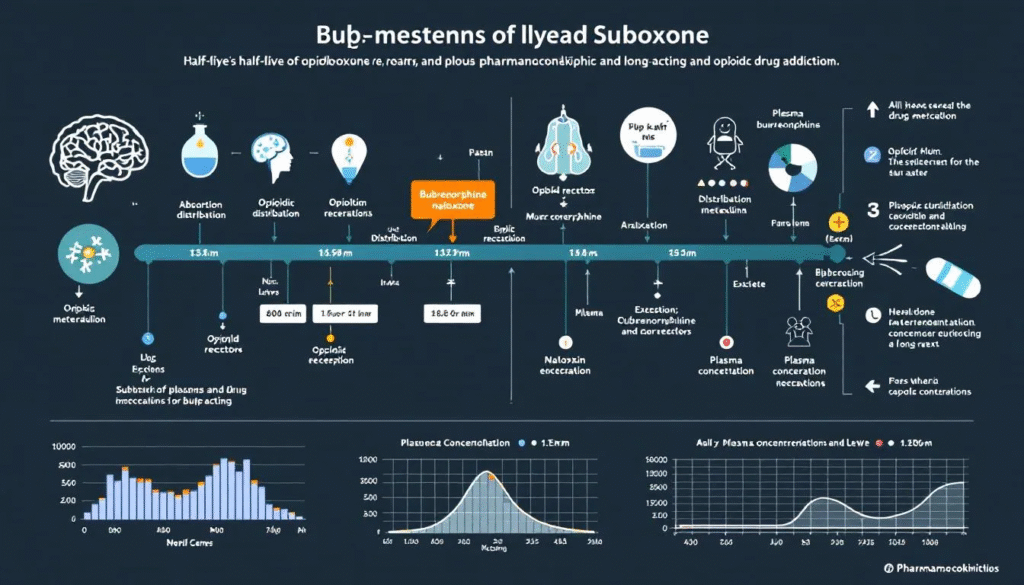
The half-life of a drug is a critical factor in understanding its duration in the body. The long half life of buprenorphine in Suboxone ranges from 24 to 42 hours, meaning it takes about this time for the body to eliminate half of the drug. Buprenorphine functions as a partial agonist, producing milder effects compared to full opioids.
Naloxone, on the other hand, has a shorter half-life ranging from 2 to 12 hours. Suboxone is primarily eliminated through urine and feces, ensuring that the body gradually clears the drug over time.
Common Suboxone Withdrawal Symptoms
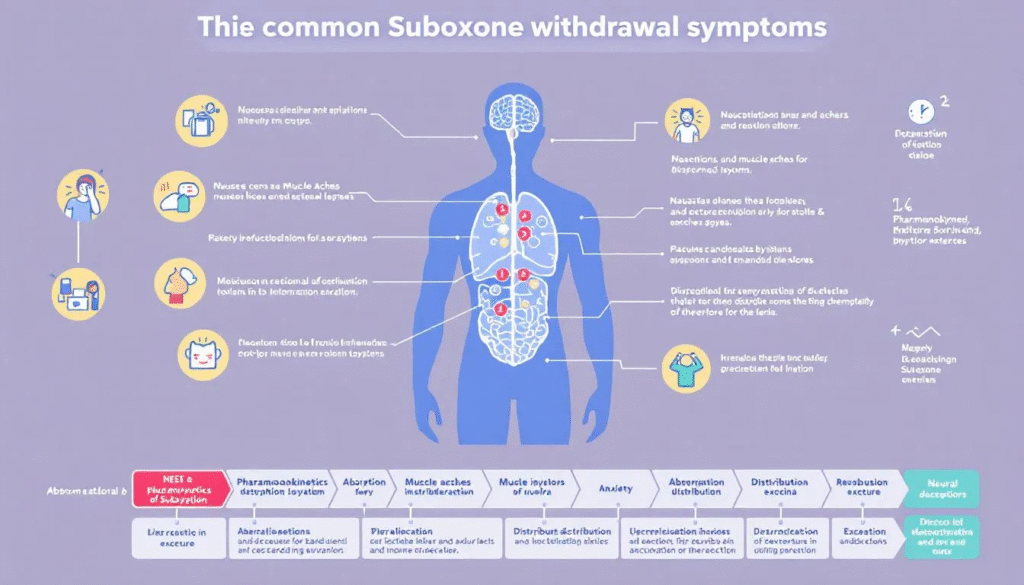
Withdrawal from Suboxone can be challenging, with symptoms typically beginning 24 to 72 hours after the last dose. Common withdrawal symptoms include opioid withdrawal symptoms such as:
- Irritability
- Muscle aches
- Nausea
- Fatigue
- Flu-like symptoms such as muscle aches and chills
- Gastrointestinal problems like vomiting and diarrhea
These symptoms can vary in intensity among individuals.
Psychological symptoms, including:
- irritability
- mood swings are also common. The duration of withdrawal symptoms and severe withdrawal symptoms can last:
- from one week to one month
- with some post-acute symptoms persisting for several months.
Managing Suboxone Withdrawal
Managing Suboxone withdrawal requires a comprehensive approach. The typical duration of withdrawal symptoms can last from days to weeks. Long-term Suboxone use can extend for months or even years, potentially influencing withdrawal experiences.
Medical detoxification involves flushing the drug out under medical supervision to ensure safety. To avoid withdrawal symptoms, it is crucial to perform a gradual taper of the medication. Various treatments for alcohol dependence can help ease withdrawal symptoms, including medication, therapy, and support groups.
Suboxone Addiction Treatment Options
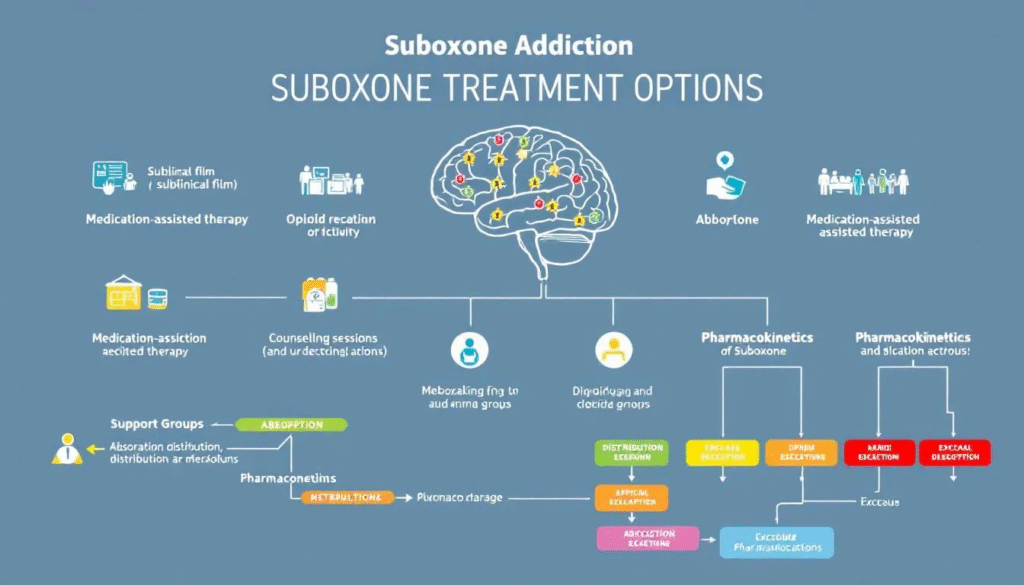
There are several treatment options available for Suboxone addiction. Common programs include:
- Medical detox
- Inpatient rehab
- Partial hospitalization
- Intensive outpatient
- Traditional outpatient rehab aftercare
For help choosing the right rehab center, see our list of the best rehab centers in America.
Inpatient rehabilitation provides a distraction-free environment, helping individuals focus solely on recovery.
Outpatient and partial hospitalization programs offer flexibility, allowing individuals to receive a treatment program while maintaining daily responsibilities. Medications for opioid use disorder (MOUD) are effective in supporting recovery by normalizing brain chemistry and alleviating cravings. Behavioral therapy combined with medication enhances the chances of successful recovery.
Does Suboxone Show Up on Standard Drug Tests?
Suboxone typically does not show up on standard drug tests for opioids. Specific tests are needed to detect buprenorphine, the active ingredient in Suboxone. These specialized tests are designed to ensure adherence and prevent misuse.
Certain medications, such as cough suppressants and antihistamines, can trigger false positive results for opioids. Food items like poppy seeds can also cause false positives. The sensitivity of remote drug tests may be lower compared to laboratory tests, affecting accuracy.
False Positives and Drug Testing
False positives in drug tests for Suboxone are relatively rare but possible, with estimates suggesting that about 5-10% of tests may yield inaccurate results. Several factors can lead to false positives, including human error, other medications, and instrumental carry-over.
If a false positive occurs, clinicians may recommend retesting to investigate further. Understanding the potential for false positives can help in managing expectations and ensuring accurate test results.
Seeking Professional Help for Opioid Addiction
Seeking professional help from a healthcare provider for opioid addiction is crucial. Good Samaritan Laws in many states protect individuals who seek medical help during an overdose from drug possession charges. Recovery is possible with the right support and treatment strategies.
Reducing stigma around addiction is essential for encouraging individuals to seek necessary health services. Suboxone is a medication authorized for treating opioid dependence in adults and adolescents over 15 years old. Comprehensive treatment programs provide structured support for individuals battling opioid addiction.
Summary
Understanding how long Suboxone stays in your system is crucial for managing treatment and preparing for drug tests. Factors such as dosage, metabolism rate, and liver function play significant roles in detection times. Different testing methods, including urine, blood, saliva, and hair tests, offer varying detection windows.
Withdrawal from Suboxone can be challenging, but with the right management strategies, it is possible to ease symptoms and support recovery. Treatment options for Suboxone addiction include medical detox, inpatient rehab, and outpatient programs, among others. Seeking professional help and reducing stigma around addiction are vital steps towards recovery.
In conclusion, knowledge is power. By understanding the intricacies of Suboxone, you can better manage your treatment and support your journey towards a healthier life. Stay informed, stay empowered, and take control of your recovery.
Frequently Asked Questions
How long does Suboxone stay in your system?
Suboxone generally remains detectable in your system for approximately 7 to 10 days, though this duration may vary based on individual factors such as age, weight, and metabolism.
Can Suboxone be detected in a standard drug test?
Suboxone is generally not detected in standard drug tests for opioids, as specialized tests are required to identify its active component, buprenorphine. Therefore, if a standard test is administered, Suboxone is unlikely to be revealed.
What are the common withdrawal symptoms from Suboxone?
Common withdrawal symptoms from Suboxone include irritability, muscle aches, nausea, fatigue, flu-like symptoms, gastrointestinal issues, and mood swings. It is important to be aware of these symptoms if you are considering discontinuing use.
What factors influence how long Suboxone stays in your system?
The duration Suboxone stays in your system is influenced by dosage, frequency of use, metabolism, liver function, age, overall health, and any existing medical conditions. These factors collectively determine how quickly the drug is processed and eliminated from the body.
What are some treatment options for Suboxone addiction?
Effective treatment options for Suboxone addiction encompass medical detox, inpatient rehabilitation, and various outpatient programs, alongside behavioral therapy and medications for opioid use disorder. Engaging in a comprehensive treatment plan is essential for recovery.




